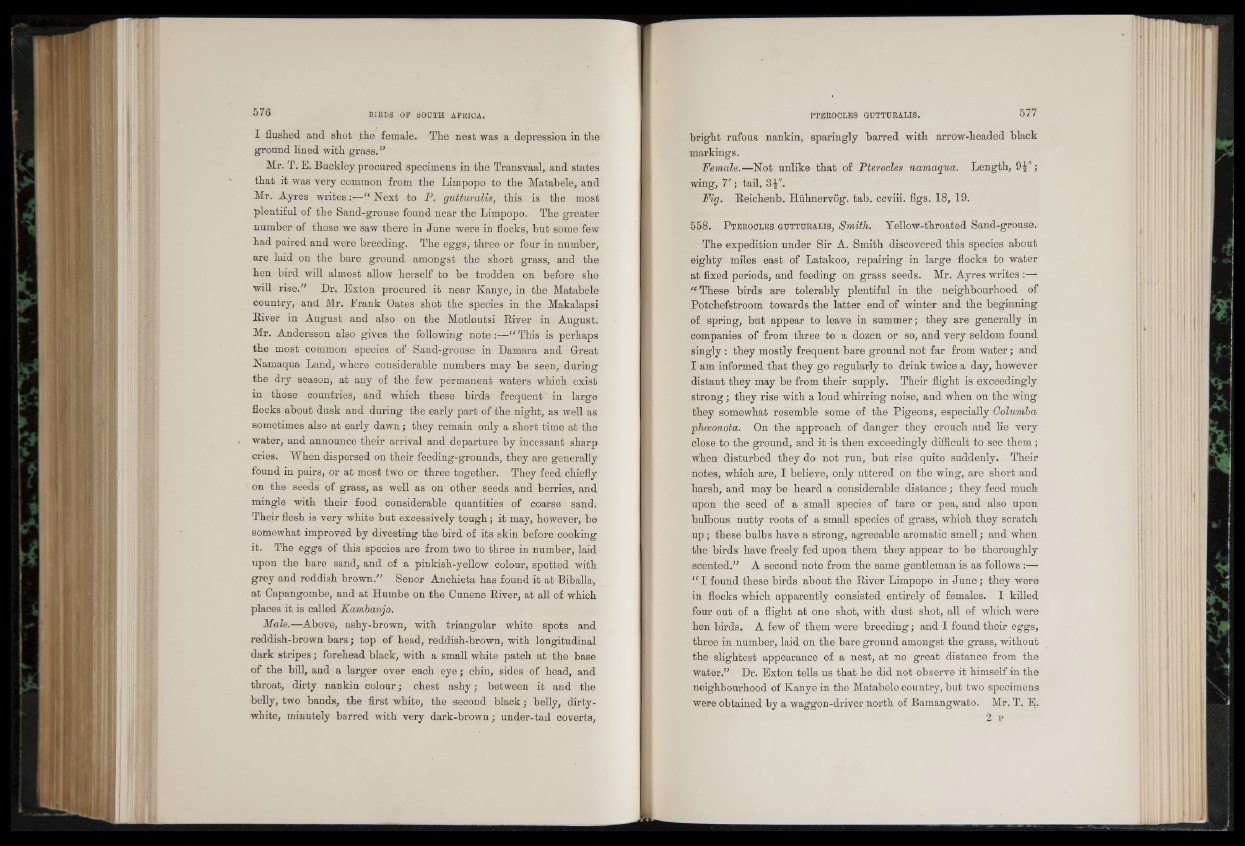
I flushed and shot the female. The nest was a depression in the
ground lined with grass.”
Mr. T. E. Buckley procured specimens in the Transvaal, and states
that it was very common from the Limpopo to the Matabele, and
Mr. Ayres writes:—“ Next to P. gutturalis, this is the most
plentiful of the Sand-grouse found near the Limpopo. The greater
number of those we saw there in June were in flocks, but some few
had paired and were breeding. The eggs, three or four in number,
are laid on the bare ground amongst the short grass, and the
hen bird will almost allow herself to be trodden on before she
will rise.” Dr. Exton procured it near Kanye, in the Matabele
country, and Mr. Frank Oates shot the species in the Makalapsi
River in August and also on the Motloutsi River in August.
Mr. Andersson also gives the following note :—“ This is perhaps
the most common species of Sand-grouse in Damara and Great
Namaqua Land, where considerable numbers may be seen, during
the dry season, at any of the few permanent waters which exist
in those countries, and which these birds frequent in large
flocks about dusk and during the early part of the night, as well as
sometimes also at early dawn; they remain only a short time at the
water, and announce their arrival and departure by incessant sharp
cries. When dispersed on their feeding-grounds, they are generally
found in pairs, or at most two or three together. They feed chiefly
on the seeds of grass, as well as on other seeds and berries, and
mingle with their food considerable quantities of coarse sand.
Their flesh is very white but excessively tough; it may, however, be
somewhat improved by divesting the bird of its skin before cooking
it. The eggs of this species are from two to three in number, laid
upon the bare sand, and of a pinkish-yellow colour, spotted with
grey and reddish brown.” Senor Anchieta has found it at Biballa,
at Capangombe, and at Humbe on the Cunene River, at all of which
places it is called Kambanjo.
Male.—Above, ashy-brown, with triangular white spots and
reddish-brown bars; top of head, reddish-brown, with longitudinal
dark stripes; forehead black, with a small white patch at the base
of the bill, and a larger over each eye; chin, sides of head, and
throat, dirty nankin colour ; chest ashy; between it and the
belly, two bands, the first white, the second black; belly, dirty-
white, minutely barred with very dark-brown; under-tail coverts,
bright rufous nankin, sparingly barred with arrow-headed black
markings.
Female.—Not unlike that of Pterocles namaqua. Length, ;
wing, 7"; tail, 3^".
Fig. Reichenb. Hiihnervog. tab. ccviii. figs. 18, 19.
558. P t e r o c l e s g u t t u r a l i s , Smith. Yellow-throated Sand-grouse.
The expedition under Sir A. Smith discovered this species about
eighty miles east of Latakoo, repairing in large flocks to water
at fixed periods, and feeding on grass seeds. Mr. Ayres writes :—
“ These birds are tolerably plentiful in the neighbourhood of
Potchefstroom towards the latter end of winter and the beginning
of spring, but appear to leave in summer; they are generally in
companies of from three to a dozen or so, and very seldom found
singly : they mostly frequent bare ground not far from water; and
I am informed that they go regularly to drink twice a day, however
distant they may be from their supply. Their flight is exceedingly
strong; they rise with a loud whirring noise, and when on the wing
they somewhat resemble some of the Pigeons, especially Golumba
\phoeonota. On the approach of danger they crouch and lie very
close to the ground, and it is then exceedingly difficult to see them;
when disturbed they do not run, but rise quite suddenly. Their
notes, which are, I believe, only uttered on the wing, are short and
harsh, and may be heard a considerable distance; they feed much
upon the seed of a small species of tare or pea, and also upon
bulbous nutty roots of a small species of grass, which they scratch
up; these bulbs have a strong, agreeable aromatic smell; and when
the birds have freely fed upon them they appear to be thoroughly
scented.” A second note from the same gentleman is as follows :—
“ I found these birds about the River Limpopo in June; they were
in flocks which apparently consisted entirely of females. I killed
four out of a flight at one shot, with dust shot, all of which were
hen birds. A few of them were breeding; and I found their eggs,
three in number, laid on the bare ground amongst the grass, without
the slightest appearance of a nest, at no great distance from the
water.” Dr. Exton tells us that he did not observe it himself in the
neighbourhood of Kanye in the Matabele country, but two specimens
were obtained by a waggon-driver north of Bamangwato. Mr. T. E..
2 p